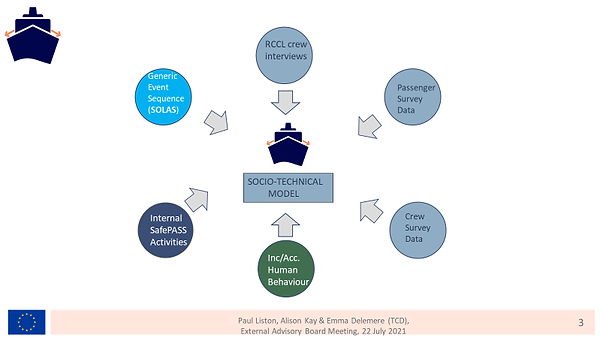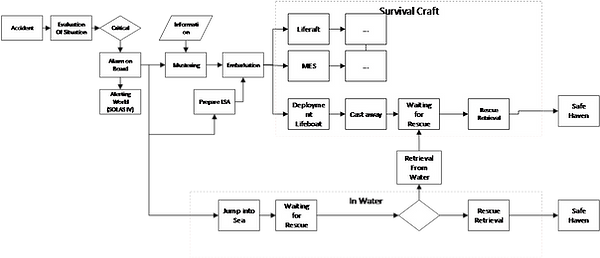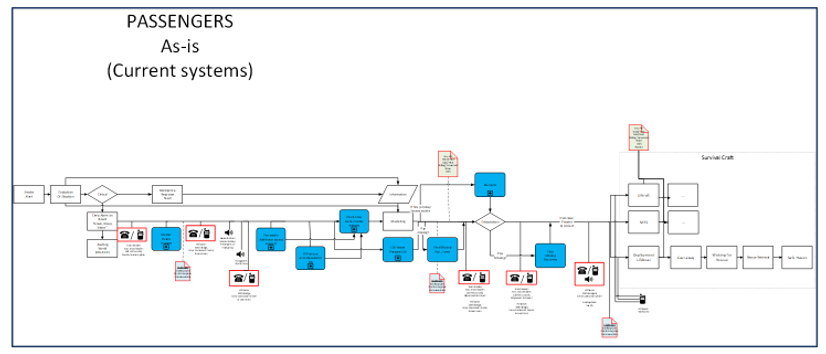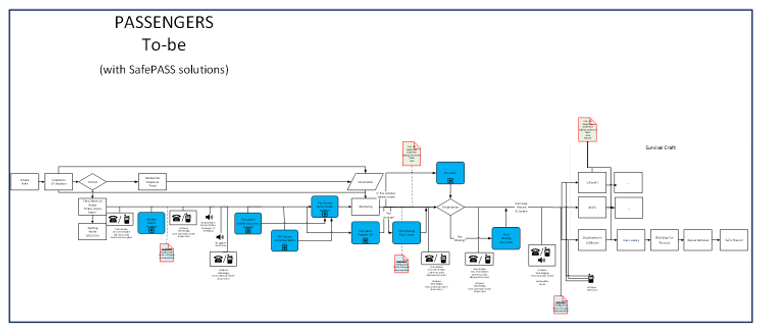SafePASS
NEWS
SafePASS
NEWS
COMING SOON
COMING SOON
NEWS
WP7 Sociotechnical Assessment of Evacuations: Current and Future
The SafePASS project seeks to develop an integrated system to support passenger and crew safe and timely muster and abandonment during emergencies, and through this redefine the evacuation processes, systems/equipment, and international regulations for passenger ships. SafePASS systems/components include the provision of optimal evacuation routes through near real-time monitoring of passenger and crew activity, and enhanced, easy-to-use LSA with the overall aim of reducing time required for ship evacuation. The sociotechnical assessment assessment provides sociotechnical and behavioural analyses of mustering and abandonment of large passenger ships, with reference to both the current practice (As-is) and future (To-be) processes which employ the SafePASS systems/components. This also provides perspectives on the usability, accessibility, efficacy, and integrity for deskilled evacuations of passenger ships from crew and passenger perspectives are discussed for both the current process of mustering and abandoning ship and when using SafePASS systems/components.
Why is a sociotechnical analysis important?
A sociotechnical analysis is not merely a gap analysis of where we are now and where we would like to be in the future. It also provides recommendations for how technologies should be implemented and provides valuable feedback on how the system needs to be supported from both an organisational and regulatory perspective.
Data
Data for the sociotechnical analysis came from multiple sources represented in the figure below:

-
Generic Event Sequence for Escape and Abandonment (SOLAS)
-
RCCL Cruise Operator Crew interviews
-
Passenger survey data
-
Crew survey data
-
Human Behaviour Analyses from incident & accident reports across multiple transport industries
-
Other SafePASS activities
-
workshops with internal SafePASS partners (class societies, technology developers, ship designers, risk analysts etc.)
-
SafePASS Risk Model
-
workshops with expert stakeholders from the SafePASS External Advisory Board (EAB)
-
-
Documentation from industry and end-user groups
Process Maps
The process maps used the SOLAS generic event sequence for Escape and Abandonment (shown below) as the foundation upon which to add information.

Maps of current Evacuation Systems (the As-is process)
Data from all sources were used to populate the maps. Maps were produced for a wide variety of stakeholder roles including:
-
Passengers
-
Passengers with specific access requirements
-
Master
-
Staff Captain
-
Hotel Director
-
Safety Officer
-
Human Resource Director
-
Staff Chief Engineer
-
First Officer
-
Second Officer
-
Housekeeping Supervisor
-
Medical Team
-
Mobile Fire Crew
-
LSA operators
Each map is accompanied with a narrative describing the stakeholder role during the same scenario-based emergency requiring mustering and abandonment. As can be seen below, there are numerous blue boxes which represent additional tasks and subtasks that have been added. There are also six communication boxes (depicting phones and radios) that have been highlighted in red to denote a point in the process that presents a communication bottleneck. Other boxes that have been highlighted in red represent performance shaping factors and challenges presented to the stakeholder at the relevant point in the operational process. The sociotechnical analysis was cross referenced with the risk model for the SafePASS project to ensure that potential hazards are represented at each critical point in the process. The hazards have not been shown here for confidentiality reasons. In total, 11 elements of the map have been highlighted in red.

Maps of future Evacuation Systems (the To-be process)
As can be seen below, there are fewer elements highlighted in red. This is due to there no longer being communication bottlenecks and increased risk in the system. Stakeholders reported that they would have far fewer communication tasks as a result of the SafePASS solutions supporting them with significantly better situational awareness, and improved decision making. Crew reported that the SafePASS technologies would support them in being able to do their job in terms of reduced stress, thus allowing more time and energy to be spent on reassuring passengers and fellow crew. Improved crowd management and a knock-on effect of “contagious calm” were anticipated outcomes by stakeholders from the implementation of SafePASS solutions.

Recommendations
Industry Stakeholders and External Advisory Board members were convinced that SafePASS systems would make the evacuation and abandonment of large passenger ships safer, faster and smarter. They also made recommendations on how SafePASS could be implemented with regards to data protection and future regulation. These recommendations are included in the sociotechnical analysis and will form the basis for the implementation roadmap which will be produced in year 3 of the SafePASS project.
